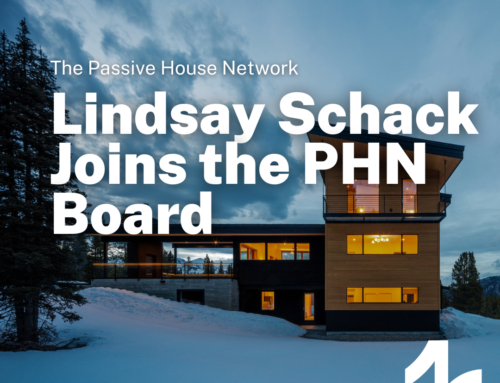The Passive House Network Announces Buildings Tour for Boston Conference
Download the Press Release
Visit the Conference Website
Register for the Tour
The Buildings Tour is a great way to see Passive House in-action, hear directly from the professionals with their work, and make new Passive House friends along the way.
Boston, MA, May 16, 2022 – The Passive House Network announced the Conference Passive House Buildings Tour for Passive House 2022 Conference: Passive House For All. The Tour will take place on June 18.
The Tour will include site visits to a wide variety of build types: office tower, multifamily apartment building, a single-family home and a school – demonstrating how Passive House can be utilized successfully in a wide variety of uses.
The tour will start early with the 53-story Winthrop Center. Developed by MP Boston, it’s a building that’s in the process of redefining expectations for Class A office space performance – with 21 floors built for Passive House certification. Under construction, the building details and systems will be live illustrations of Passive House principles in action. The building is designed by Handel Architects, and built by Suffolk.
Next stop is The Loop at Mattapan Station, with 135 rental-units planned to accommodate occupants with a range of incomes. It is also under construction. The architects are The Architectural Team (TAT) and the builder is Dellbrook JKS.
From the multifamily, we then stop at a single-family home in Somerville. Completed a number of years ago, it was certified by the owner after construction was done, who has gone on to become a Certified Passive House Designer, founding eMod Studio.
With a late lunch stop, it’s on to Beverly MA and the Waring School, where the school’s new 12,000 SF academic building was recently completed to Passive House standards. The architect is OPAL Architecture and the builder, L.D. Russo.
“The tour is intended to give a concentrated look into a variety of building types, connect people, educate and inspire,” said Tour organizer Ken Levenson. “If you don’t walk away motivated to change business as usual and energetically confront the climate crisis by the end of the tour, we’ll suspect you didn’t get off the bus!”
With participants loaded with motivation and many new Passive House friends, the Tour ends with a drop-off back in downtown Boston.
Find out more and register at https://phnconference.org/
# # #
About PHN:
The Passive House Network (PHN), formerly known as NAPHN, is a 501(c)3 that provides Passive House high-performance building education and resources to professionals across the U.S. that transform how they think and work with buildings. PHN provides professionals a complete skill set to reliably produce new and renovated buildings that use dramatically less energy for effective and affordable climate action. https://passivehousenetwork.org/
About PHI:
The Passive House Institute (PHI) is an independent research institute that has played an especially crucial role in the development of the Passive House concept – the only internationally recognized, performance-based energy standard in construction. https://passivehouse.com/
About PHMA:
Passive House Massachusetts is a member-based, non-profit organization that focuses on education, training, outreach, and advocacy to accomplish its goals. PHMA regularly hosts meetings, trainings, tours, and other events related to Passive House design and construction and serves as a hub of knowledge for high-performance design in the state and region. https://phmass.org/
About Passive House:
Passive House is an international building standard and methodology, applicable to buildings of all kinds from office buildings to hospitals, new-build and renovations, that results in a dramatic drop in operational energy use, and more comfortable and healthy occupants – meant to aggressively mitigate our climate crisis while providing resilient adaptation.
The Passive House Standard was developed by the Passive House Institute (PHI), an independent scientific research organization, located in Darmstadt, Germany, and includes specific requirements for energy use and comfort of occupants. The Passive House Standard is being successfully applied to thousands of buildings and millions of square feet around the world, from Boston to Beijing.
The Passive House methodology starts with reducing cooling, dehumidification, and heating loads by focusing, not on gadgets and active technology, but instead on fully integrated durable passive building components, such as proper continuous thermal-bridge-free insulation, continuous airtightness, high-performance windows and doors, and ventilation that includes a high-efficiency heat/energy recovery core, carefully calculated, and all integrated with the entire architectural process of design and construction. http://www.passivehouse.com http://www.passipedia.org
The International Passive House Association is a membership, communications, and global community-building arm of the Passive House Institute with over 30 affiliated regional Passive House organizations around the world. https://passivehouse-international.org/
Get Trained:
Introductory Training Options
Core Certification Training Options
Specialized Training Options





